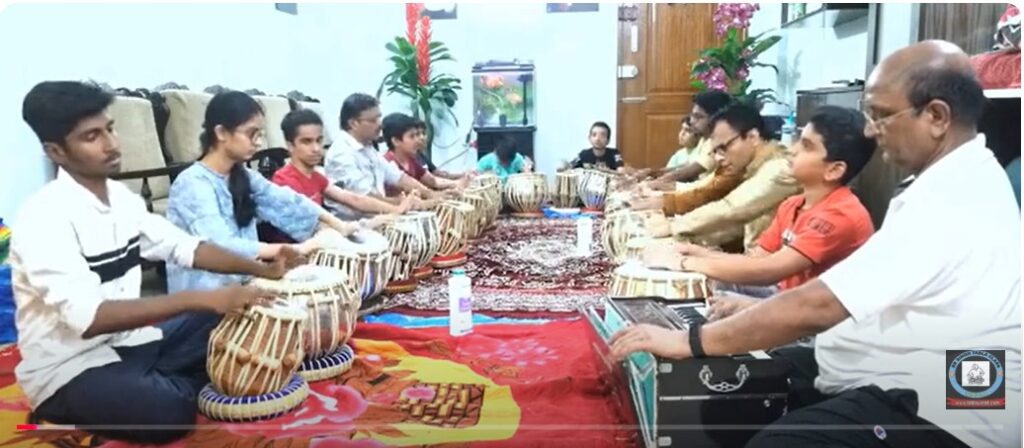Introduction
Tabla, the heart of Indian rhythm, is home to countless taals (rhythmic cycles) that shape classical and devotional music. While Teentaal (16 beats) and Jhaptal (10 beats) are widely known, there exist rare and mystical rhythms that hold deep spiritual significance. One such unique rhythmic cycle is Lakshmi Taal, an 18-beat taal associated with auspiciousness, devotion, and Indian classical traditions. In this blog, we will explore the structure, notation, and significance of Lakshmi Taal, along with its use in music and performance.
What is Lakshmi Taal?
Lakshmi Taal is an 18-beat rhythmic cycle that is named after Goddess Lakshmi, the Hindu deity of wealth, prosperity, and fortune. It is often played in devotional music, temple rituals, and classical compositions dedicated to divine themes. Unlike common taals, which have symmetrical structures, Lakshmi Taal has a unique rhythmic flow that makes it both challenging and exciting for tabla players and musicians.
Structure of Lakshmi Taal
Lakshmi Taal is divided into four vibhags (sections) as follows:
📌 5 + 5 + 4 + 4
This division gives the taal a distinctive pulse, creating a sense of movement and energy that aligns well with its spiritual significance.
Theka (Basic Tabla Pattern) of Lakshmi Taal
The theka (basic beat pattern) of Lakshmi Taal is:
👉 Dha Dhin Dhin Dha Dha | Dha Tin Tin Ta Ta | Tin Tin Tin Tin | Dha Dhin Dhin Dha
Each segment has its own unique accents, making this taal sound both intricate and powerful.
Notation of Lakshmi Taal
Here’s a matra-wise breakdown of Lakshmi Taal’s structure:
| Matra | Bol (Stroke) |
|---|---|
| 1 | Dha |
| 2 | Dhin |
| 3 | Dhin |
| 4 | Dha |
| 5 | Dha |
| 6 | Dha |
| 7 | Tin |
| 8 | Tin |
| 9 | Ta |
| 10 | Ta |
| 11 | Tin |
| 12 | Tin |
| 13 | Tin |
| 14 | Tin |
| 15 | Dha |
| 16 | Dhin |
| 17 | Dhin |
| 18 | Dha |
This rhythmic structure provides a sense of symmetry yet unpredictability, making it an exciting taal to perform.
Significance of Lakshmi Taal in Music
Lakshmi Taal is considered auspicious and divine due to its connection with Goddess Lakshmi. It is often performed in:
🎵 Devotional Music & Bhajans: Used in prayers and temple music.
🎵 Classical & Semi-Classical Music: Occasionally found in Kathak and Hindustani compositions.
🎵 Fusion & Experimental Music: Modern musicians have explored Lakshmi Taal in fusion settings.
Its flowing rhythm and balanced divisions make it perfect for compositions that require a blend of steadiness and complexity.
How to Practice Lakshmi Taal?
Mastering Lakshmi Taal requires patience and practice. Here are some key tips:
✅ Start Slow: Focus on each section of the taal before playing it continuously.
✅ Recite the Bols: Vocalizing the strokes helps in internalizing the rhythm.
✅ Use a Metronome or Lehra: Playing with a lehra (melodic loop) keeps the rhythm steady.
✅ Experiment with Variations: Once comfortable, try adding kaidas, tukras, and rela patterns within the 18-beat cycle.
Comparison: Lakshmi Taal vs. Ganesh Taal
Lakshmi Taal and Ganesh Taal are both 18-matra taals, but they have different structures:
| Feature | Lakshmi Taal | Ganesh Taal |
|---|---|---|
| Matra (Beats) | 18 | 18 |
| Vibhag Division | 5+5+4+4 | 6+6+2+4 |
| Flow | Balanced and devotional | Asymmetrical and dynamic |
| Common Usage | Bhajans, Classical Music | Classical, Kathak, Fusion |
Both taals are rarely used but highly rewarding to learn, as they challenge rhythmic perception and improvisation skills.
Conclusion
Lakshmi Taal is a divine and powerful 18-beat rhythm that holds deep cultural and spiritual significance in Indian music. Its structured yet flowing pattern makes it an intriguing taal for tabla players, dancers, and musicians. Whether you’re a beginner or an advanced tabla enthusiast, mastering Lakshmi Taal will expand your rhythmic vocabulary and bring a new dimension to your playing.
💬 Have you ever played Lakshmi Taal? Share your thoughts in the comments!
🎶 Looking for a demonstration? Watch this Lakshmi Taal performance to hear its beauty in action!
Keep practicing, and may your rhythms be as divine as Lakshmi Taal! 🙏🎵
O

https://www.youtube.com/@BhagawanSingh
https://www.facebook.com/sbsinghtablaguru


